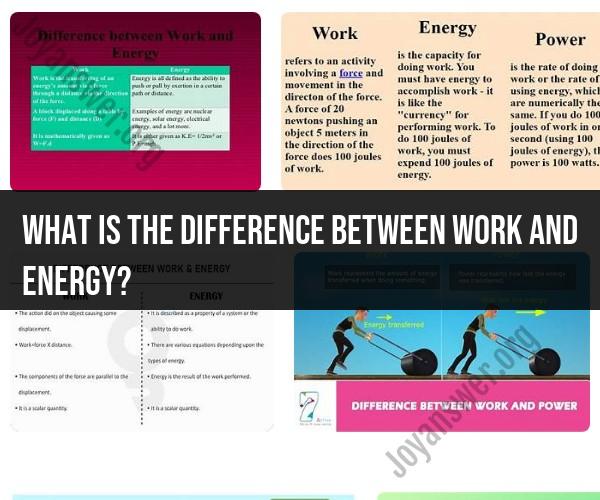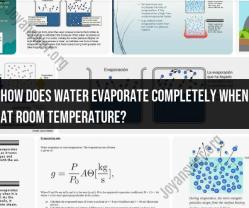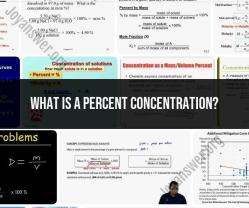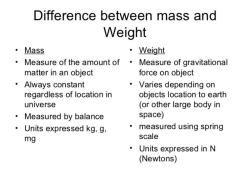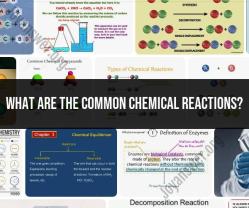What is the difference between work and energy?
Work and energy are related concepts in physics, but they have distinct definitions and characteristics. Here are the key differences between work and energy:
Definition:
- Work: Work is defined as the product of the force applied to an object and the displacement of the object in the direction of the force. Mathematically, it is expressed as , where is work, is the force, is the displacement, and is the angle between the force and the displacement.
- Energy: Energy is the ability to do work. It is a scalar quantity that represents the capacity of a system or an object to perform work. Energy can exist in various forms, including kinetic energy, potential energy, thermal energy, and others.
Units:
- Work: The SI unit of work is the joule (J). One joule is equivalent to one newton-meter (N·m).
- Energy: Energy is also measured in joules (J). The joule is the standard unit for all forms of energy.
Direction:
- Work: Work is a scalar quantity, which means it has magnitude but no direction. It can be positive, negative, or zero, depending on the angle between the force and the displacement.
- Energy: Energy is a scalar quantity as well and does not have a specific direction. It is a measure of the state or condition of an object or system.
Transfer and Conservation:
- Work: Work is the process of transferring energy from one system to another. When work is done on an object, energy is transferred to or from the object.
- Energy: Energy can be transferred between systems through the performance of work. However, the total energy of a closed system is conserved, following the principle of conservation of energy.
Types:
- Work: There are different types of work, including positive work (when the force and displacement are in the same direction), negative work (when they are in opposite directions), and zero work (when there is no displacement or no force applied in the direction of displacement).
- Energy: Energy exists in various forms, such as kinetic energy (energy of motion), potential energy (energy stored due to position or configuration), mechanical energy, thermal energy (heat), chemical energy, and more.
Calculation:
- Work: Work is calculated based on the force applied, the distance over which the force is applied, and the angle between the force and displacement vectors.
- Energy: Energy can be calculated based on the type of energy involved. For example, kinetic energy is calculated using , where is mass, and is velocity.
In summary, work and energy are related but distinct concepts in physics. Work is the transfer of energy due to the application of a force over a displacement, while energy is a measure of the capacity to do work. Understanding the interplay between these two concepts is essential for analyzing physical systems and their behavior.
Work vs. Energy: Unraveling the Distinction Between These Physical Concepts
Work and energy are two of the most fundamental concepts in physics. However, they are often confused or used interchangeably. It is important to understand the distinction between work and energy in order to properly apply these concepts to real-world problems.
Work is the transfer of energy from one object to another due to a force acting over a distance. It is a scalar quantity, meaning that it has magnitude but no direction. Work is measured in joules (J).
Energy is the ability to do work. It is a scalar quantity, meaning that it has magnitude but no direction. Energy can exist in many different forms, such as kinetic energy, potential energy, and thermal energy. Energy is also measured in joules (J).
The work-energy theorem states that the net work done on an object is equal to the change in its kinetic energy. This means that work can be used to increase or decrease the kinetic energy of an object.
Energy and Work in Physics: Clarifying the Differences
One way to clarify the difference between work and energy is to think about the following example:
Imagine a ball sitting on a table. The ball has potential energy because it is elevated above the ground. If you lift the ball up and then release it, the ball will fall to the ground. As the ball falls, it converts its potential energy into kinetic energy.
In this example, the work done on the ball is equal to the change in its kinetic energy. The work is done by the force of gravity, and the kinetic energy is gained by the ball as it falls.
Another way to clarify the difference between work and energy is to think about the following example:
Imagine a car driving down the road. The car has kinetic energy because it is moving. If you step on the brakes, the car will slow down. As the car slows down, it converts its kinetic energy into thermal energy.
In this example, the work done on the car is equal to the negative of the change in its kinetic energy. The work is done by the force of friction, and the kinetic energy is lost by the car as it slows down.
A Matter of Definitions: Work and Energy in Scientific Context
Here are the scientific definitions of work and energy:
- Work: Work is the transfer of energy from one object to another due to a force acting over a distance.
- Energy: Energy is the ability to do work.
It is important to note that work is a process, while energy is a state. This means that work is done over a period of time, while energy is possessed by an object.
Another important distinction between work and energy is that work can be positive or negative, while energy can only be positive. This is because work can be used to increase or decrease the energy of an object.
I hope this helps to clarify the distinction between work and energy. These are two fundamental concepts in physics, and it is important to understand their difference in order to properly apply them to real-world problems.
